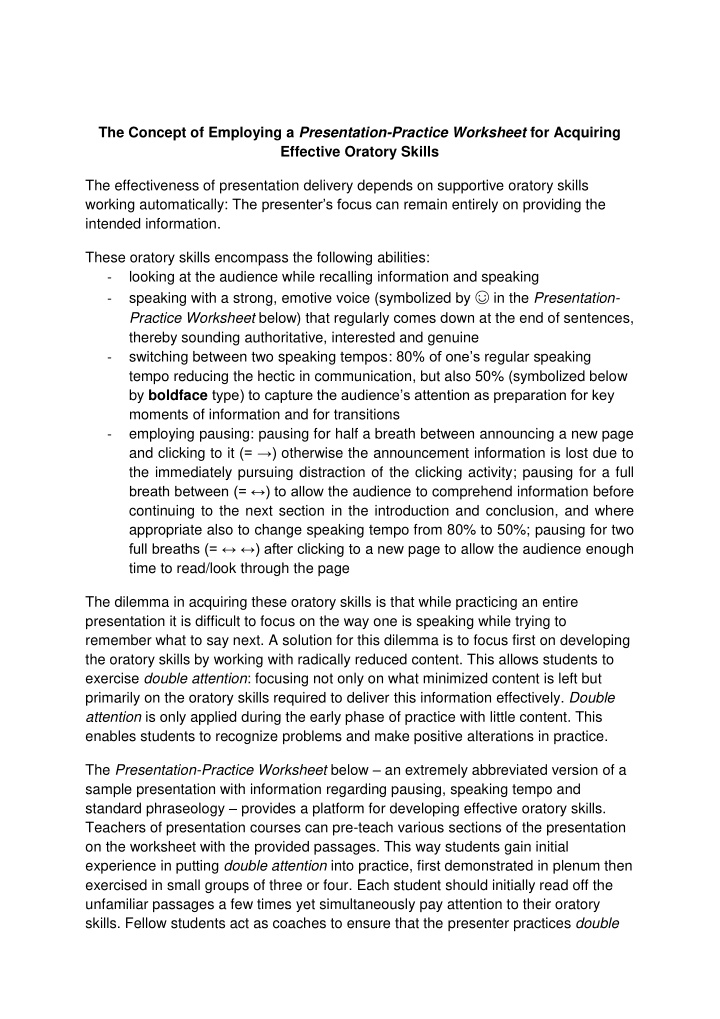



The Concept of Employing a Presentation-Practice Worksheet for Acquiring Effective Oratory Skills The effectiveness of presentation delivery depends on supportive oratory skills working automatically: T he presenter’s focus can remain entirely on providing the intended information. These oratory skills encompass the following abilities: - looking at the audience while recalling information and speaking speaking with a strong, emotive voice (symbolized by ☺ in the Presentation- - Practice Worksheet below) that regularly comes down at the end of sentences, thereby sounding authoritative, interested and genuine switching between two speaking tempos: 80% of one’s regular speaking - tempo reducing the hectic in communication, but also 50% (symbolized below by boldface type) to capture the audience’s attention as preparation for key moments of information and for transitions - employing pausing: pausing for half a breath between announcing a new page and clicking to it (= →) otherwise the announcement information is lost due to the immediately pursuing distraction of the clicking activity; pausing for a full breath between (= ↔) to allow the audience to comprehend information before continuing to the next section in the introduction and conclusion, and where appropriate also to change speaking tempo from 80% to 50%; pausing for two full breaths (= ↔ ↔) after clicking to a new page to allow the audience enough time to read/look through the page The dilemma in acquiring these oratory skills is that while practicing an entire presentation it is difficult to focus on the way one is speaking while trying to remember what to say next. A solution for this dilemma is to focus first on developing the oratory skills by working with radically reduced content. This allows students to exercise double attention : focusing not only on what minimized content is left but primarily on the oratory skills required to deliver this information effectively. Double attention is only applied during the early phase of practice with little content. This enables students to recognize problems and make positive alterations in practice. The Presentation-Practice Worksheet below – an extremely abbreviated version of a sample presentation with information regarding pausing, speaking tempo and standard phraseology – provides a platform for developing effective oratory skills. Teachers of presentation courses can pre-teach various sections of the presentation on the worksheet with the provided passages. This way students gain initial experience in putting double attention into practice, first demonstrated in plenum then exercised in small groups of three or four. Each student should initially read off the unfamiliar passages a few times yet simultaneously pay attention to their oratory skills. Fellow students act as coaches to ensure that the presenter practices double
attention in order to be able to implement positive alterations with each new practice attempt. Then in a second round everyone practices the section again, this time working from memory without anyone (presenters or coaches) employing the worksheet. Everyone makes an effort not only to remember what to say but to speak effectively too. Initial practice can begin with the section entitled Greeting the audience , later Introducing oneself , then perhaps a week later combining the two sections into one extended block. It is best to practice single sections before combining them pairwise, and then practicing ever larger combined blocks of sections. Practice for developing one’s oratory skills should be carried out systematically on most sections of a presentation throughout the first half of a course. Such practice enables students later to work on their own, perhaps with the aid of a recording device to monitor themselves. At this point students should customize the worksheet by replacing the sample gray-marked passages in italics with passages from their own presentation. Then students practice in like fashion with their own customized version of the Presentation-Practice Worksheet . Acquiring effective oratory skills is not at all a matter of text memorization which exerts an oppressive burden on the speaker ’s ability for recall. The standard passages do not have to be learned by heart. Rather students should know what to do section by section and thereby come to develop trust in themselves to be able to find adequate formulations that serve the task at hand. Having established effective oratory skills greatly lightens the burden of presenters because they can now focus entire on providing the details of their presentation. At this point, students can initiate practice of the presentation in its entirety. Practice with their own customized Presentation-Practice Worksheet can be carried out in the same manner with future presentations on different topics. After applying such practice to just a few presentations, students will have acquired these effective oratory skills for life. In fact this kind of practice should work for presentations in other languages as well (assuming allowances are made for cultural differences). The most essential of all these oratory skills concerns pausing because it not only ensures that the audience is provided the opportunity for grasping the information just provided, it also allows presenters to better remember what comes next and to prepare for the next activity. In other words, effective employment of pausing substantially reduces the pressure brought about by the compulsion to speak incessantly. At all times the speaker can completely concentrate on the present activity without having to worry about what comes next.
Recommend
More recommend